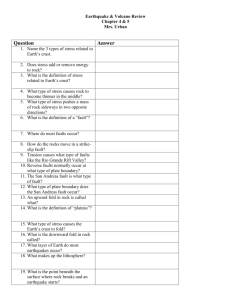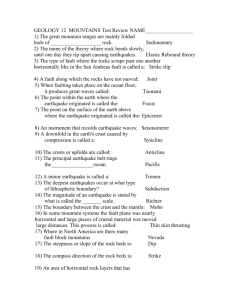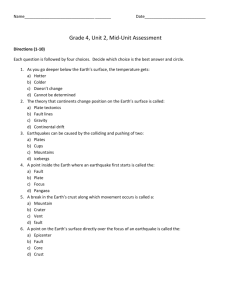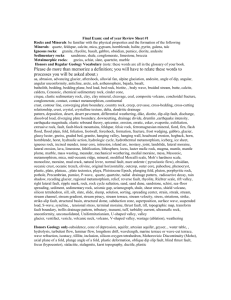MOUNTAINS and METAMO..
advertisement
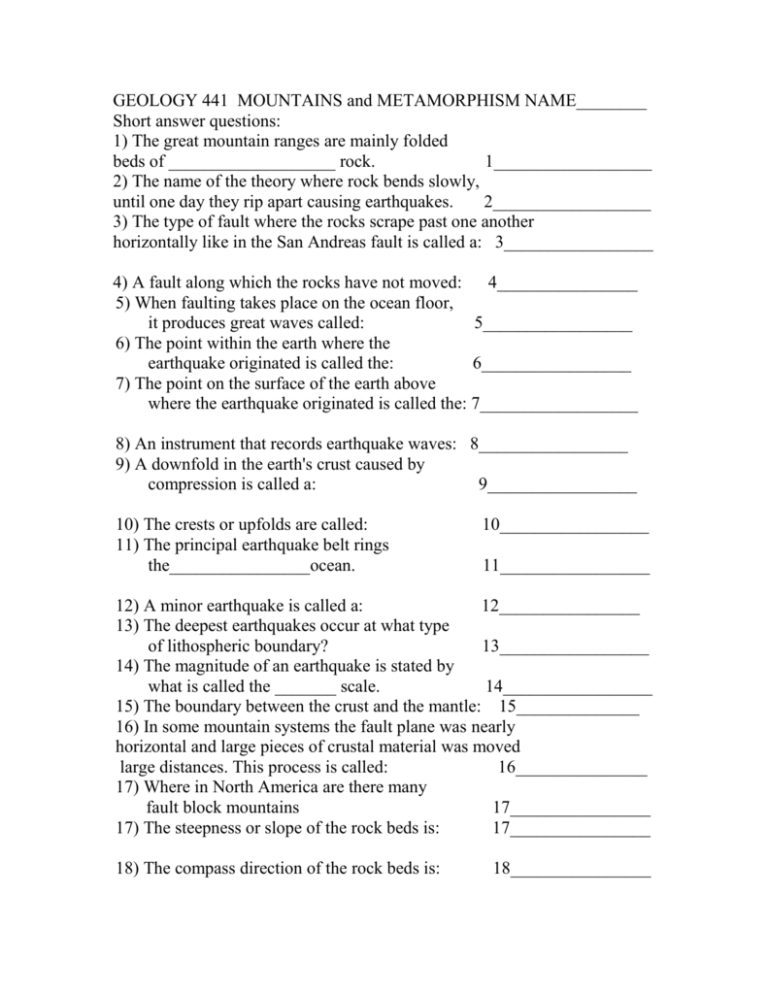
GEOLOGY 441 MOUNTAINS and METAMORPHISM NAME________ Short answer questions: 1) The great mountain ranges are mainly folded beds of ___________________ rock. 1__________________ 2) The name of the theory where rock bends slowly, until one day they rip apart causing earthquakes. 2__________________ 3) The type of fault where the rocks scrape past one another horizontally like in the San Andreas fault is called a: 3_________________ 4) A fault along which the rocks have not moved: 4________________ 5) When faulting takes place on the ocean floor, it produces great waves called: 5_________________ 6) The point within the earth where the earthquake originated is called the: 6_________________ 7) The point on the surface of the earth above where the earthquake originated is called the: 7__________________ 8) An instrument that records earthquake waves: 8_________________ 9) A downfold in the earth's crust caused by compression is called a: 9_________________ 10) The crests or upfolds are called: 11) The principal earthquake belt rings the________________ocean. 10_________________ 11_________________ 12) A minor earthquake is called a: 12________________ 13) The deepest earthquakes occur at what type of lithospheric boundary? 13_________________ 14) The magnitude of an earthquake is stated by what is called the _______ scale. 14_________________ 15) The boundary between the crust and the mantle: 15______________ 16) In some mountain systems the fault plane was nearly horizontal and large pieces of crustal material was moved large distances. This process is called: 16_______________ 17) Where in North America are there many fault block mountains 17________________ 17) The steepness or slope of the rock beds is: 17________________ 18) The compass direction of the rock beds is: 18________________ 19) An area of horizontal rock layers that has high relief(1000 meters or more) is called a: 19________________ 20) A nearly circular folded mountain 20________________ 21) List the five stages of metamorphism of shale: 21.___________22______________23_____________24_____________ 25___________ 26) Metamorphosed sandstone is: 26___________________ 27) Metamorphosed limestone is: 27___________________ 28) The great mountain ranges have gigantic cores of _____rock. 29) What is the exposed surface of the North American core called? 30) A mountain formed by the displacement of rock along a fault is called? 31) A fault in which the movement is parallel to the dip is called? 32) A fault in which the movement is parallel to the Strike is called? 33) In what position is most sedimentary rock formed. (Horizontal or vertical)? 34) Where are the Cascades? 35) Where are the Alps and Urals? 36) Where are the Appalachians? 37) Where are the Andes? 38) Where are the Rockies? 39) Where are the Himalayas? 40) What is the name of a large shallow ocean basin that continually receives sediment but never fills up? 41) SHORT ANSWER QUESTIONS: (1) What are the P and S waves? (2) Describe how the location of an earthquake is determined? (3) How did we learn that the outer core was liquid? (4) What three facts must an earthquake prediction forecast? (5) List three observations that are being used to forecast earthquakes. (6) (a) What is a Horst? (b) What is a Rift valley? (7) What two evidences is there to show that uplift of the earth's crust has occurred? (8) (a) What is a geosyncline? (b) What makes geosynclines sink? (9) Sometimes beds of layered rock may be overturned. State three ways to determine whether this has occurred, by looking at the structures within the layer. (10) What is the difference between a plutonic dome and a tectonic dome? (11) List and briefly describe the three agents of Metamorphism. (12) List and briefly describe the three settings of Metamorphism. (13) Define (a) diastophism, (b) foliation. (14) Label the diagrams.
